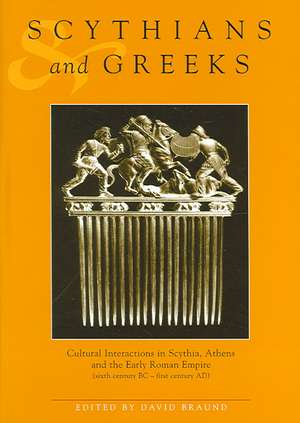Scythians And Greeks: Cultural interaction in Scythia, Athens and the early Roman empire (sixth century BC to first century AD)
Editat de David Braunden Limba Engleză Hardback – 23 mai 2005
Scythians and Greeks focuses on the ancient history of the northern Black Sea region: a major 'new frontier' of Classical studies.
The book presents a series of engagements with key themes bearing on cultural interactions within the region, from archaic Greek colonial settlement (approx. sixth century BC) down to the region's inclusion within the Roman imperial system (first century AD). By bringing together contributors from Russia, Ukraine and Georgia, the book makes available material and ideas which are either wholly new or known only to a very limited circle of specialists. The particular focus is on the relationships which developed, in peace and war, between the local peoples of the region (conventionally termed 'Scythians') and the cultures of the classical Graeco-Roman world.
Preț: 839.51 lei
Preț vechi: 1150.00 lei
-27% Nou
Puncte Express: 1259
Preț estimativ în valută:
160.66€ • 166.71$ • 134.28£
160.66€ • 166.71$ • 134.28£
Carte tipărită la comandă
Livrare economică 18 martie-01 aprilie
Preluare comenzi: 021 569.72.76
Specificații
ISBN-13: 9780859897464
ISBN-10: 085989746X
Pagini: 288
Ilustrații: approx 20 halftones
Dimensiuni: 249 x 183 x 23 mm
Greutate: 0.89 kg
Editura: Liverpool University Press
Colecția Liverpool University Press
ISBN-10: 085989746X
Pagini: 288
Ilustrații: approx 20 halftones
Dimensiuni: 249 x 183 x 23 mm
Greutate: 0.89 kg
Editura: Liverpool University Press
Colecția Liverpool University Press
Notă biografică
David Braund is Professor of Ancient History, University of Exeter. His particular specialism lies in the Black Sea region, especially Russia, Ukraine and Georgia, and he speaks Russian and Georgian fluently. His books include The Administration of the Roman Empire (Exeter, 1988); Georgia in Antiquity: A History of Transcaucasian Georgia, 550 BC-AD 562 (Oxford, 1994); Ruling Roman Britain: Kings, Queens, Governors and Emperors from Caesar to Agricola (Routledge, 1996).
Cuprins
Introduction by David Braund
E.H. Minns and M.I. Rostovtzeff: glimpses of a Scythian friendship by Gregory Bongard-Levin, Head of Ancient History at the Institute of History, Moscow, and a full Academician
Key points in Scythian history by V.Yu. Murzin, Head of the Scythian Department of the Institute of Archaeology, Kiev
Scythian kings and “royal” burial-mounds of the fifth and fourth centuries BC by A.Yu. Alekseyev, Head of Scythian Collection, Hermitage Museum, St Petersburg
Masters and workshops of the jewellery and toreutics from fourth century Scythian burial mounds by Mikhail Treister, Humboldt Fellow in Germany in recent years, after a long career in Moscow museums
Snake-limbed and tendril-limbed goddesses in the art and mythology of the Mediterranean and Black Sea by Yulia Ustinova, Lecturer, Ben Gurion University, Israel, following a career in the Academy of Sciences, Moscow
Who were the “Scythian” archers on archaic Attic vases? by A.I. Ivanchik, Institute of General History, Moscow and University of Bordeaux
Bobbies or boobies? The Scythian police force in Classical Athens by Balbina Baebler, Honorary Fellow in Classics at University of Exeter
Olbia and the Scythians in the fifth century B.C.: the Scythian “protectorate” by S.D. Kryzhitskiy, Head of the Classical Department of the Institute of Archaeology, Kiev, and Director of the main Greek site in Ukraine (ancient Olbia)
The lower Dnieper region as an area of Greek/Barbarian interaction by Valeria Bylkova, Head of the Classical Section, Kherson Museum
The civic frontiers of Tauric Chersonesus in the fourth century B.C. by M.I. Zolotaryov
North-east Azov in the Scythian period: a sketch by K.K. Marchenko, Institute of the History of Material Culture, St Petersburg
The Development of Graeco-barbarian contacts in the chora of the European Bosporus (sixth–first centuries) by A.A. Maslennikov, Institute of Archaeology, Moscow
A new inscription from Scythian Neapolis: the tomb of Argotas, lord of horse-rearing Scythia by Yu.G. Vinogradov, latterly Institute of History, Moscow and Yu.P. Zaytsev, a Crimean excavator
Thrace and the Bosporus under the early Roman emperors by Sergey Saprykin, Institute of History, Moscow
The Crimean Campaign of Tiberius Plautius Silvanus by V.M. Zubar, Institute of Archaeology, Kiev
Bibliography
